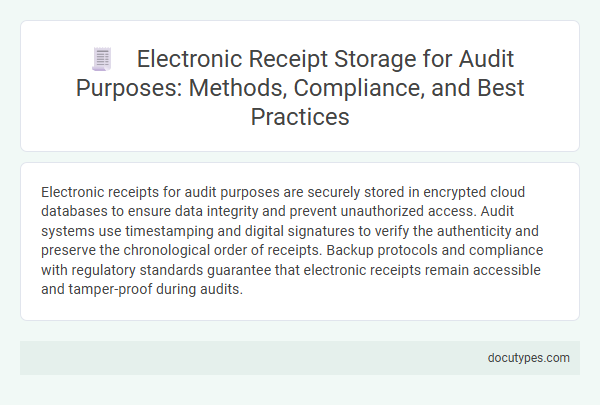Electronic receipts for audit purposes are securely stored in encrypted cloud databases to ensure data integrity and prevent unauthorized access. Audit systems use timestamping and digital signatures to verify the authenticity and preserve the chronological order of receipts. Backup protocols and compliance with regulatory standards guarantee that electronic receipts remain accessible and tamper-proof during audits.
Introduction to Electronic Receipt Storage
Electronic receipts are digital records of transactions stored for verification and auditing. Your business relies on secure storage methods to ensure receipt integrity and easy access.
- Cloud Storage - Electronic receipts are often saved in cloud-based systems for scalability and remote access.
- Encrypted Databases - Receipts are stored in encrypted databases to protect sensitive financial information.
- Audit Trail Integration - Storage systems maintain detailed audit trails to track receipt creation and modifications.
Effective electronic receipt storage supports compliance with regulatory requirements and simplifies audit processes.
Importance of Receipts in Audit Processes
Electronic receipts are securely stored in encrypted digital databases to ensure integrity and accessibility during audits. These systems maintain detailed time-stamped records, facilitating traceability and compliance with regulatory standards.
Receipts serve as crucial evidence in audit processes, verifying transactions and supporting financial accuracy. Proper storage of electronic receipts enhances transparency and simplifies the verification of expenses and revenues for auditors.
Methods for Storing Electronic Receipts
Electronic receipts are stored using secure digital methods designed to maintain data integrity and facilitate easy retrieval during audits. These storage solutions comply with regulatory requirements to ensure authenticity and prevent tampering.
- Cloud Storage - Electronic receipts are saved in encrypted cloud servers, enabling scalable storage and remote access for auditors.
- Blockchain Technology - Receipts are recorded on blockchain ledgers to provide immutable and time-stamped proof of transactions.
- Enterprise Resource Planning (ERP) Systems - Integrated ERP systems store receipts alongside financial records, streamlining audit processes and compliance management.
Key Compliance Requirements for Digital Receipt Storage
Electronic receipts are stored using secure, encrypted digital systems to ensure data integrity and accessibility for audits. Compliance with regulatory standards such as GDPR, HIPAA, and IRS guidelines mandates proper retention periods and data protection measures.
Key compliance requirements include maintaining audit trails, ensuring non-repudiation, and enabling easy retrieval of electronic receipts. Digital storage solutions must incorporate timestamping and secure access controls to prevent unauthorized modifications. Adhering to these standards helps organizations pass audits and avoid penalties related to improper record-keeping.
Security Standards for Electronic Receipt Management
Electronic receipts are stored using encryption protocols complying with industry security standards such as PCI DSS and GDPR to ensure data confidentiality and integrity. Storage systems often utilize secure cloud platforms with multi-factor authentication and access controls to prevent unauthorized access during audits. You can trust that these measures protect receipt data while maintaining easy retrieval for audit purposes.
Best Practices for Organizing and Indexing Receipts
Electronic receipts are stored using secure digital storage systems that ensure data integrity and easy access during audits. Best practices involve organizing receipts by date, vendor, and transaction type to facilitate quick retrieval and verification. Indexing receipts with unique identifiers and metadata such as invoice numbers and payment details enhances accuracy and efficiency in audit processes.
Integrating Receipt Storage with Accounting Systems
Electronic receipts are stored securely within integrated accounting systems to ensure audit readiness and compliance. This integration allows seamless synchronization of receipt data with financial records for accurate auditing.
- Automated Data Capture - Electronic receipts are automatically imported into accounting platforms to reduce manual entry errors and improve data accuracy.
- Centralized Storage - All receipts are stored in a centralized digital repository within the accounting system, facilitating easy retrieval during audits.
- Compliance and Security - Integration ensures receipts meet legal retention requirements with encrypted storage to protect sensitive financial information.
Retention Periods and Legal Considerations
Electronic receipts are stored digitally using secure cloud-based systems or dedicated servers to ensure data integrity and easy retrieval during audits. Retention periods for these receipts vary by jurisdiction, typically ranging from 3 to 7 years depending on local tax laws and business regulations.
Legal considerations require that electronic receipts remain unaltered and accessible throughout the retention period, complying with standards such as GDPR or HIPAA where applicable. Your business must implement strict access controls and backup procedures to meet these audit requirements and avoid penalties.
Overcoming Common Challenges in Audit-Ready Storage
| How Are Electronic Receipts Stored for Audit Purposes? | |
|---|---|
| Storage Methods | Electronic receipts are stored using secure cloud-based platforms or specialized accounting software. These systems ensure receipts are archived in formats compliant with regulatory standards such as PDF/A or XML. The use of encryption and access controls protects sensitive financial data from unauthorized access. |
| Data Integrity | To maintain audit readiness, electronic receipts are often timestamped and digitally signed. This process preserves the authenticity and prevents tampering. Automated backups protect against data loss, ensuring receipt information is fully retrievable during audits. |
| Indexing and Retrieval | Receipts are categorized by vendor, date, transaction type, or amount. Efficient indexing enables quick retrieval, an essential factor during audits. Optical Character Recognition (OCR) technology further enhances search capabilities by extracting text from scanned receipts. |
| Compliance with Regulations | Compliance with local tax authorities and standards, such as GAAP or IFRS, is pivotal. Storing electronic receipts in audit-ready formats ensures alignment with legal record-keeping requirements and the ability to present documentation upon request. |
| Overcoming Common Challenges | Challenges include data fragmentation, varying file formats, and inconsistent retention policies. Centralizing receipt storage in a unified system resolves fragmentation. Standardizing file formats and implementing clear retention schedules avoid confusion and ensure that your electronic receipts remain accessible and audit-ready. |
How Are Electronic Receipts Stored for Audit Purposes? Infographic

